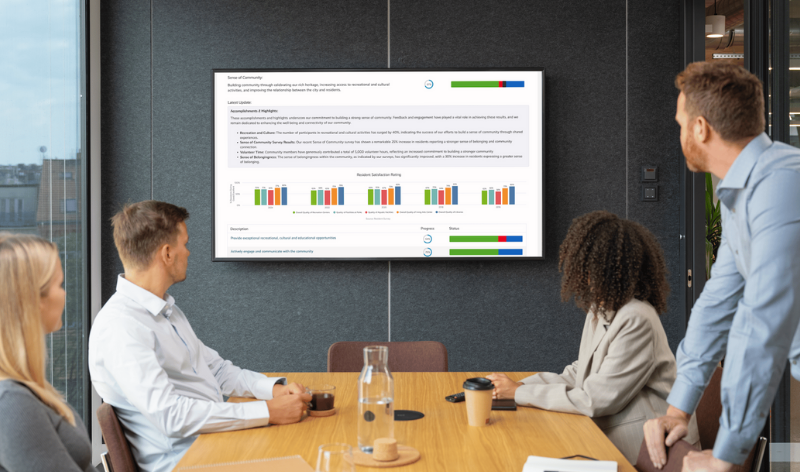Contents
Benchmarking is the practice of comparing key performance measures, trends, and management processes with peer organizations. It is an invaluable tool for measuring your performance successes and potential areas for improvement.
Forward-thinking local governments can benefit significantly from the insights that benchmarking with their peers provides. Some organizations may find value in benchmarking their organization’s performance measures over time to see where progress is being made–for others that are further into their performance management journey, the value may be found in peer-to-peer comparisons which let your local government or public sector organization better understand how similar entities get better results.
We strongly recommend working towards both! Either way, implementing a benchmarking framework can help you build operational capacity for making data-informed decisions and policies that drive positive change for your key stakeholders.
If you are considering implementing a benchmarking program, here are seven key benefits you can expect.
1. Compare your performance with peers
By joining a regional benchmarking group, such as the Valley Benchmark Communities group in Arizona, local governments can jointly create and access valuable comparative data that, due to proximity, is highly relevant to their own efforts. This data can be used to provide visibility into areas where those organizations are over or underperforming in relation to their peers, and identify what the high-performers are doing differently in order to excel. These kinds of actionable insights can inform positive policy and operational changes for peer communities. Being able to measure your performance in any given service area, especially within the context of selected peer groups who are tracking the same measures, is invaluable for organizations looking to provide better services for their constituents.
2. Understand performance trends
Whether individually or in a group, benchmarking is an extremely effective tool for the observation, analysis, and reporting of performance over a specific time frame. Once a performance measure has been defined, it can be tracked and benchmarked for consistency over time. By doing so, local governments can use this data as a key resource to fuel evidence-based decision making, allocate resources, and to promote a culture of continuous improvement.
3. Identify areas for improvement
Optimism is an essential currency in the public sector, but even the best-run organizations will admit that there are areas where they can improve. Implementing an effective benchmarking program can help identify these areas–by comparing key performance metrics with peers, you can work to understand where you are under-performing or failing to deliver on critical services.
It’s not about who is “best” or “worst”, though–identifying areas for improvement is critical to understanding how to deliver better results for your residents and key stakeholders, and the good news is that it is likely your peers have ideas or proven remedies for improved performance. Benchmarking communities often find that developing a shared pool of best practices, resources, and even vendors can be just as helpful as developing common performance metrics. Regional local government benchmarking is about building better and stronger communities across the board.
4. Celebrate strengths
In the same spirit, benchmarking can provide local governments with definitive insights into their strengths relative to the standard. For example, let’s say that through a benchmarking program you are able to ascertain that your fire response times are in the ninetieth percentile as compared to the national average–that’s amazing, and should be commended! By placing your organization’s performance in the context of performance of others and over time, it becomes much easier to identify your strengths and celebrate those wins in your organization and your community. Trust me when I say your team will appreciate you for it!
There are practical applications to this exercise, as well. Perhaps your city council has earmarked funds to improve your fire department performance, but the results above revealed that those funds aren’t really necessary–all of a sudden, you have an insight that wasn’t available prior and you can allocate those crucial resources to an area that is more in need of them.
5. Be more transparent
At Envisio, we’re big believers in the idea that nobody achieves anything alone, and the collaborative element of benchmarking is consistently cited as one of the practice’s greatest returns. There’s significant value in partnering with your neighbors to share your knowledge, learn from their experiences, and establish better protocols and programs that help you deliver on your organization’s mission. Doing so raises the bar not just for you, but for everyone.
Similarly, putting together a benchmarking framework, and making that data consistently available for the public to review, can help encourage the openness and transparency that is required for residents to trust their government. Working with your neighbors to build this culture of trust and transparency is essential to ensuring that our democratic institutions and public sector organizations remain efficient and effective in achieving their goals.
6. Keep up with current trends
Life in local government can move pretty quickly, and understanding trends with and across the industry is invaluable for organizations who are striving to elevate their performance and improve the quality-of-life for their communities. Benchmarking against other like-minded organizations can provide a window into the latest-and-greatest in technology or consulting partners, procurement best practices, and other important opportunities and innovations. As with some other examples here, these best practices and key insights wouldn’t be possible without a benchmarking framework.
7. Reestablish trust in your agency
We know that governments that foster trust are better able to govern, and can act with confidence on key issues like budgeting, policy-making, and community outreach. Participating in a local government benchmarking network signals to your council and community that continuous improvement and innovation are your top priorities, and that you are willing to be open and transparent with your results.
Our research tells us that local governments can build public trust by doing what they say they are going to, responding to community issues and problems, and by being open and transparent with their communities.
Local governments that benchmark are leading the way towards making evidence-based decisions the default in public sector work. These organizations are tracking their progress, identifying what works and what doesn’t, and uncovering new ways to better deliver on their key services and overarching mission. Benchmarking is a throughline for the most innovative public sector of organizations–it can provide the information necessary for mid-course adjustments, for identifying and terminating programs that aren’t delivering value, for finding operational efficiencies, and reframing difficult discussions about where scarce resources are needed most.



